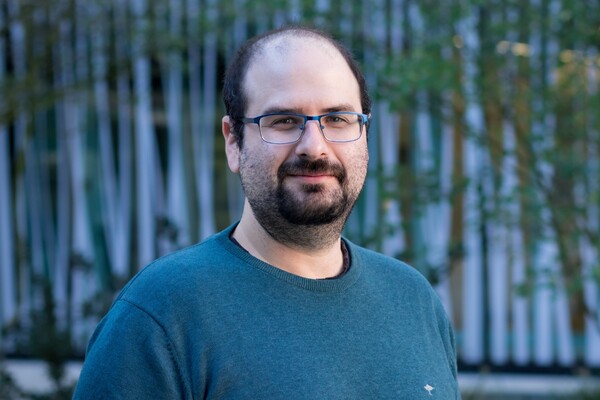Main Second Level Navigation
Nabeel Shah wins 2024 Donnelly Centre Research Thesis Prize

The Donnelly Centre for Cellular and Biomolecular Research recognizes an outstanding thesis produced by one of its PhD graduates each year with the Donnelly Centre Research Thesis Prize. The Thesis Prize is awarded based on the quality, originality and significance of the PhD graduate’s work.
The 2024 recipient of the Thesis Prize is Syed Nabeel Haider Shah, a PhD graduate who conducted research under the supervision of Jack Greenblatt, university professor of molecular genetics.
Shah earned a Bachelor of Science degree in Biology, with a minor in Psychology, and a Master of Science degree in Molecular Biology from the Toronto Metropolitan University. Following graduation from his master’s program, Shah joined the Greenblatt lab at the Donnelly Centre as a PhD Student.
“I moved to Canada in 2007 to pursue an undergraduate education,” said Shah. “It was a bit tough being a new immigrant, and I had to deal with the challenges of a language barrier and a completely different education system. However, everything worked out fine because people are generally helpful and supportive.”
Shah developed a fascination with molecular biology as an undergraduate student, which led to his master’s research on chromatin assembly and regulation in Tetrahymena, a commonly studied single-cell organism. Shah studied protein-protein interactions in Tetrahymena to learn how they work in an evolutionarily divergent organism.
Shah’s master’s advisor, associate professor of chemistry and biology Jeffrey Fillingham, recommended that Shah join the Greenblatt lab based on his own experience of working as a postdoctoral fellow in the lab.
At the time Shah was considering joining the Greenblatt lab, its members were focused on studying protein-protein interactions and transcriptional regulation. Upon joining, Shah moved the lab in a new direction towards post-transcriptional regulation. While the lab had previously conducted research on the role of C2H2 zinc finger proteins as DNA binding factors, exploring their role as RNA binding factors was new territory.
C2H2 zinc finger proteins are believed to function as DNA binding transcriptions factors, although only a few among more than 700 of them are well-studied. The Greenblatt lab suspected that these proteins may be involved in RNA biology; to confirm this theory, they had to determine if the proteins naturally bind to RNA in cells.
Shah found that this group of proteins could bind to both DNA and RNA, indicating their involvement in a wide range of important cellular processes. He tested 150 C2H2 zinc finger proteins, out of which 148 were found to interact with RNA in cells, and created RNA binding maps for around 50 of them to show where they bind to RNA.
He studied a few of the newly identified RNA binding proteins in great detail, learning that two of them have potential roles in cancer development and treatment: one of the proteins can enhance the ability of cancer cells to develop into tumours, while the other can perform the reverse role by suppressing growth of tumour cells. These findings offer new targets for cancer treatment.
Shah also optimized the iCLIP-seq method to study C2H2 zinc finger protein interactions with RNA, which resulted in a significant improvement in the efficiency of existing methods for determining binding sites on RNA. His optimized tool led to collaborations and contributions to research across the Donnelly Centre, as well as publications in high-impact journals.
Shah’s main collaborative partners at the Donnelly Centre include Benjamin Blencowe, Timothy Hughes and Zhaolei Zhang – all professors of molecular genetics. The Blencowe lab brought expertise in RNA biology to Shah’s research, and was particularly helpful in getting his C2H2 zinc finger project off the ground. The Hughes lab provided assistance with documenting the newly discovered group of RNA binding proteins by studying their sequence specificity and identifying their RNA binding regions. The Zhang lab provided computational assistance in analyzing large-scale sequencing data.
“Nabeel has had an extraordinary PhD career,” said Greenblatt. “He published 25 peer-reviewed papers from research he conducted over the course of his studies, with lead authorship on 12 of them – and he continues to publish papers from his thesis work. Nabeel made the most of his PhD by contributing significantly and widely across biomedicine.”
Shah credits Greenblatt for being an extremely supportive advisor who provided guidance while allowing him to work independently to develop research projects. Greenblatt always made himself available to Shah over the decade they worked together, which encouraged Shah’s personal development as an independent scientist.
“I believe if I was a PhD student in any other lab, it wouldn’t have been possible for me to accomplish as much as I did,” said Shah.
“On behalf of the Thesis Prize selection committee, I would like to congratulate Nabeel on the truly impressive collection of work that comprises his thesis,” said Henry Krause, professor of molecular genetics and chair of the Donnelly Centre Research Thesis Prize selection committee. “He was selected to receive the 2024 prize because of his demonstration that a large class of proteins previously considered to be DNA binding transcription factors work also – or instead – as RNA binding proteins with key roles in RNA metabolism and function. Notably, one of these proteins had been studied for many decades as the prototype of vertebrate DNA binding transcription factors. His work is a major breakthrough in the field of RNA biology.”
Shah hopes to continue working in academia, with a long-term goal of starting his own research lab. He is currently pursuing postdoctoral fellow positions, as well as semi-independent research fellow positions. He plans to continue conducting research on post-transcriptional regulation and RNA biology.
News



